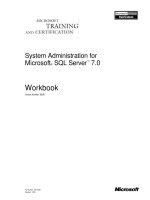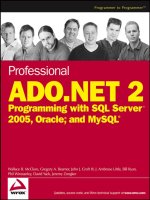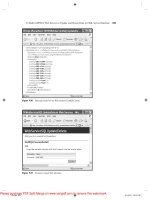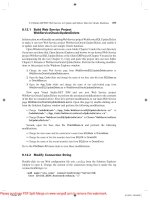Tài liệu Defensive Database Programming with SQL Server ppt
Bạn đang xem bản rút gọn của tài liệu. Xem và tải ngay bản đầy đủ của tài liệu tại đây (3.23 MB, 302 trang )
Defensive Database
Programming with
SQL Server
Alex Kuznetsov
High Performance SQL Server
ISBN: 978-1-906434-44-1
Defensive Database
Programming with
SQL Server
By Alex Kuznetsov
Technical Review by Hugo Kornelis
First published by Simple Talk Publishing 2010
Copyright Alex Kuznetsov 2010
ISBN 978-1-906434-44-1
The right of Alex Kuznetsov to be identified as the author of this work has been asserted by him in accordance
with the Copyright, Designs and Patents Act 1988.
All rights reserved. No part of this publication may be reproduced, stored or introduced into a retrieval system,
or transmitted, in any form, or by any means (electronic, mechanical, photocopying, recording or otherwise)
without the prior written consent of the publisher. Any person who does any unauthorized act in relation to this
publication may be liable to criminal prosecution and civil claims for damages.
This book is sold subject to the condition that it shall not, by way of trade or otherwise, be lent, re-sold, hired
out, or otherwise circulated without the publisher's prior consent in any form other than that in which it is
published and without a similar condition including this condition being imposed on the subsequent publisher.
Technical Review by Hugo Kornelis
Technical edit by Tony Davis
Cover Photography by Paul Vlaar & Photodynamic
Typeset & Designed by Matthew Tye & Gower Associates
Table of Contents
Introduction 11
What this book covers 12
What this book does not cover 17
Code examples 17
Chapter 1: Basic Defensive Database Programming Techniques 19
Programming Defensively to Reduce Code Vulnerability 20
Define your assumptions 20
Rigorous testing 21
Defending Against Cases of Unintended Use 22
Defending Against Changes in SQL Server Settings 29
How SET ROWCOUNT can break a trigger 30
How SET LANGUAGE can break a query 38
Defensive Data Modification 43
Updating more rows than intended 43
The problem of ambiguous updates 45
How to avoid ambiguous updates 49
Summary 55
Chapter 2: Code Vulnerabilities due to SQL Server Misconceptions 57
Conditions in a WHERE clause can evaluate in any order 57
SET, SELECT, and the dreaded infinite loop 64
Specify ORDER BY if you need ordered data 72
Summary 74
Chapter 3: Surviving Changes to Database Objects 77
Surviving Changes to the Definition of a Primary or Unique Key 78
Using unit tests to document and test assumptions 82
Using @@ROWCOUNT to verify assumptions 85
Using SET instead of SELECT when assigning variables 86
Surviving Changes to the Signature of a Stored Procedure 88
Surviving Changes to Columns 91
Qualifying column names 91
Handling changes in nullability: NOT IN versus NOT EXISTS 95
Handling changes to data types and sizes 100
Summary 103
Chapter 4: When Upgrading Breaks Code 105
Understanding Snapshot Isolation 106
When Snapshot Isolation Breaks Code 110
Trigger behavior in normal READ COMMITTED mode 113
Trigger behavior in SNAPSHOT mode 118
Building more robust triggers? 122
Understanding MERGE 123
Issues When Triggers Using @@ROWCOUNT Are Fired by MERGE 125
Summary 130
Chapter 5: Reusing T-SQL Code 131
The Dangers of Copy-and-Paste 132
How Reusing Code Improves its Robustness 137
Wrapping SELECTs in Views 141
Reusing Parameterized Queries: Stored Procedures versus Inline UDFs 141
Scalar UDFs and Performance 147
Multi-statement Table-valued UDFs 151
Reusing Business Logic: Stored Procedure, Trigger, Constraint or Index? 152
Use constraints where possible 152
Turn to triggers when constraints are not practical 154
Unique filtered indexes (SQL Server 2008 only) 160
Summary 160
Chapter 6: Common Problems with Data Integrity 163
Enforcing Data Integrity in the Application Layer 163
Enforcing Data Integrity in Constraints 166
Handling nulls in CHECK constraints 168
Foreign key constraints and NULLs 171
Understanding disabled, enabled, and trusted constraints 173
Problems with UDFs wrapped in CHECK constraints 180
Enforcing Data Integrity Using Triggers 192
Summary 207
Chapter 7: Advanced Use of Constraints 209
The Ticket-Tracking System 210
Enforcing business rules using constraints only 211
Removing the performance hit of ON UPDATE CASCADE 221
Constraints and Rock Solid Inventory Systems 227
Adding new rows to the end of the inventory trail 237
Updating existing rows 245
Adding rows out of date order 249
Summary 254
Chapter 8: Defensive Error Handling 255
Prepare for Unanticipated Failure 255
Using Transactions for Data Modifications 257
Using Transactions and XACT_ABORT to Handle Errors 262
Using TRY…CATCH blocks to Handle Errors 266
A TRY…CATCH example: retrying after deadlocks 267
TRY…CATCH Gotchas 273
Re-throwing errors 273
TRY…CATCH blocks cannot catch all errors 278
Client-side Error Handling 285
Conclusion 290
The paid versions of this book contain two additional chapters: Chapter 9, Surviving
Concurrent Queries and Chapter 10, Surviving Concurrent Modifications. See the
Introduction for further details.
ix
About the Author
Alex Kuznetsov has been working with object-oriented languages and databases for
more than a decade. He has worked with Sybase, SQL Server, Oracle and DB2.
He currently works with DRW Trading Group in Chicago, where he leads a team of
developers, practicing agile development, defensive programming, and database unit
testing every day.
Alex contributes regularly to the SQL Server community. He blogs regularly on sqlblog.
com, has written numerous articles on simple-talk.com and devx.com, contributed a
chapter to the "MVP Deep Dives" book, and speaks at various community events, such as
SQL Saturday.
In his leisure time, Alex prepares for, and runs, ultra-marathons.
Author Acknowledgements
First of all, let me thank Tony Davis, the editor of this book, who patiently helped me
transform what was essentially a loose collection of blog posts into a coherent book.
Tony, I greatly appreciate the time and experience you devoted to this book, your
abundant helpful advice, and your patience.
Many thanks also to Hugo Kornelis, who agreed to review the book, and went very much
beyond just reviewing. Hugo, you have come up with many highly useful suggestions
which were incorporated in this book, and they made quite a difference! I hope you will
agree to be a co-author in the next edition, and enrich the book with your contributions.
Finally, I would like to thank Aaron Bertrand, Adam Machanic, and Plamen Ratchev for
interesting discussions and encouragement.
x
About the Technical Reviewer
Hugo Kornelis is co-founder and R&D lead of perFact BV, a Dutch company that strives
to improve analysis methods, and to develop computer-aided tools that will generate
completely functional applications from the analysis deliverable. The chosen platform
for this development is SQL Server.
In his spare time, Hugo likes to share and enhance his knowledge of SQL Server
by frequenting newsgroups and forums, reading and writing books and blogs, and
attending and speaking at conferences.
11
Introduction
Resilient T-SQL code is code that is designed to last, and to be safely reused by others.
The goal of defensive database programming, and of this book, is to help you to produce
resilient T-SQL code that robustly and gracefully handles cases of unintended use, and is
resilient to common changes to the database environment.
Too often, as developers, we stop work as soon as our code passes a few basic tests to
confirm that it produces the "right result" in a given use case. We do not stop to consider
the other possible ways in which the code might be used in the future, or how our code
will respond to common changes to the database environment, such as a change in the
database language setting, or a change to the nullability of a table column, and so on.
In the short-term, this approach is attractive; we get things done faster. However, if our
code is designed to be used for more than just a few months, then it is very likely that
such changes can and will occur, and the inevitable result is broken code or, even worse,
code that silently starts to behave differently, or produce different results. When this
happens, the integrity of our data is threatened, as is the validity of the reports on which
critical business decisions are often based. At this point, months or years later, and long
after the original developer has left, begins the painstaking process of troubleshooting
and fixing the problem.
Would it not be easier to prevent all this troubleshooting from happening? Would it
not be better to spend a little more time and effort during original development, to save
considerably more time on troubleshooting, bug fixing, retesting, and redeploying? After
all, many of the problems that cause our code to break are very common; they repeat
over and over again in different teams and on different projects.
This is what defensive programming is all about: we learn what can go wrong with
our code, and we proactively apply this knowledge during development. This book
is filled with practical, realistic examples of the sorts of problems that beset database
programs, including:
• changes in database objects, such as tables, constraints, columns, and stored
procedures
• changes to concurrency and isolation levels
Introduction
12
• upgrades to new versions of SQL Server
• changes in requirements
• code reuse
• problems causing loss of data integrity
• problems with error handling in T-SQL.
In each case, the book demonstrates approaches that will help you to understand and
enforce (or eliminate) the assumptions on which your solution is based, and to improve
its robustness.
What this book covers
This book describes a lot of specific problems, and typical approaches that will lead to
more robust code, However, my main goal is more general: it is to demonstrate how to
think defensively, and how to proactively identify and eliminate potential vulnerabilities
in T-SQL code during development rather than after the event when the problems have
already occurred.
The book breaks down into ten chapters, as described below. Eight of these chapters are
available in this free eBook version; the final two chapters are included in paid versions
only.
Ch. 01: Basic Defensive Database Programming Techniques
A high level view of the key elements of defensive database programming, illustrated via
some simple examples of common T-SQL code vulnerabilities:
• unreliable search patterns
• reliance on specific SQL Server environment settings
• mistakes and ambiguity during data modifications.
Introduction
13
Ch. 02: Code Vulnerabilities due to SQL Server Misconceptions
Certain vulnerabilities occur due to a basic misunderstanding of how the SQL
Server engine, or the SQL language, work. This chapter considers three common
misconceptions:
• the WHERE clause conditions will always be evaluated in the same order; a common
cause of intermittent query failure
• SET and SELECT always change the values of variables; a false assumption can lead
to the dreaded infinite loop
• data will be returned in some "natural order" – another common cause of
intermittent query failure.
Ch. 03: Surviving Changes to Database Objects
Perfectly-functioning SQL code can sometimes be broken by a simple change to the
underlying database schema, or to other objects that are used in the code. This chapter
examines several examples of how changes to database objects can cause unpredictable
behavior in code that accesses them, and discusses how to develop code that will not
break or behave unpredictably as a result of such changes. Specific examples include how
to survive:
• changes to the primary or unique keys, and how to test and validate assumptions
regarding the "uniqueness" of column data
• changes to stored procedure signatures, and the importance of using explicitly
named parameters
• changes to columns, such as adding columns as well as modifying an existing
column's nullability, size or data type.
Ch. 04: When Upgrading Breaks Code
Some potential changes cannot be foreseen and so we cannot "weatherproof" our code
against them; we cannot know in advance, for example, how the use of a new feature
might impact our existing code when we do not know what these new features are and
how they behave. What a defensive programmer can and must do, however, is analyze
Introduction
14
fully how new features work with existing code, before using these new features in
production. Specific examples demonstrate that:
• code that works perfectly when using READ COMMITTED isolation level, may fail to
correctly enforce business rules under SNAPSHOT or READ_COMMITTED_SNAPSHOT
isolation
• code that uses @@ROWCOUNT may behave incorrectly when used after a
MERGE statement.
Ch. 05: Reusing T-SQL Code
A copy-and-paste approach to code reuse will lead to multiple, inconsistent versions
of the same logic being scattered throughout your code base, and a maintenance
nightmare. This chapter demonstrates how common logic can be refactored into a
single reusable code unit, in the form of a constraint, stored procedure, trigger, UDF, or
index. This careful reuse of code will reduce the possibility of bugs and greatly improve
the robustness of our code. Specific examples covered include the following defensive
programming techniques:
• using views to encapsulate simple queries
• using UDFs to encapsulate parameterized queries, and why UDFs may sometimes be
preferable to stored procedures for this requirement
• how to avoid potential performance issues with UDFs
• using constraints, triggers and filtered indexes to implement business logic in
one place.
Ch. 06: Common Problems with Data Integrity
Data integrity logic in the application layer is too easily bypassed, so SQL Server
constraints and triggers are valuable weapons for the defensive programmer in the fight
to safeguard the integrity of data. The only completely robust way to ensure data
integrity is to use a trusted constraint. UDFs and triggers are dramatically more
flexible than constraints, but we need to be very careful when we use them, as the
latter, especially, are dicult to code correctly and, unless great care is taken, are
vulnerable to failure during multi-row modifications, or to being bypassed altogether.
Introduction
15
Specific examples demonstrate the following defensive programming lessons:
• when testing CHECK constraints, always include rows with NULLs in your test cases
• don't make assumptions about the data, based on the presence of FOREIGN KEY or
CHECK constraints, unless they are all trusted
• UDFs wrapped in CHECK constraints are sometimes unreliable as a means to enforce
data integrity rules; filtered indexes or indexed views are safer alternatives
• triggers require exceptional care and testing during development, and may still fail in
certain cases (for example, when using Snapshot isolation).
Ch. 07: Advanced Use of Constraints
Received wisdom suggests that constraints can enforce only a very limited set of simple
rules. In fact, in many cases, developers give up on constraints much too easily; they
allow us to solve far more complex problems than many people realize. This chapter
takes two common business systems, a ticket tracking system and an inventory system,
and demonstrates how constraints can be used, exclusively, to guarantee the integrity of
the data in these systems.
Constraint-only solutions, as you will see, are pretty complex too, but they have
the advantage that, if you get them right, they will be completely robust under
all conditions.
Ch. 08: Defensive Error Handling
The ability to handle errors is essential in any programming language and, naturally, we
have to implement safe error handling in our T-SQL if we want to build solid SQL Server
code. However, the TRY…CATCH error handling in SQL Server has certain limitations
and inconsistencies that will trap the unwary developer, used to the more robust error
handling of client-side languages such as C# and Java. The chapter includes specific
advice to the defensive programmer in how best to handle errors, including:
• if you already use a modern language such as C# in your system, then it makes sense
to utilize it to do complex handling of errors related to the database
Introduction
16
• if handling errors on SQL Server, keep it simple where possible; set XACT_ABORT to
ON and use transactions in order to roll back and raise an error
• if you wish to use TRY…CATCH, learn it thoroughly, and watch out for problems such
as errors that cannot be caught, doomed transactions, the need to change the error
number when raising errors, and so on.
Ch. 09: Surviving Concurrent Queries (Paid editions only)
A query that works splendidly in isolation can often fail miserably when put to work in
a live OLTP system, with real life concurrency. To make a bad situation worse, in many
cases such errors are subtle and intermittent, and therefore very dicult to reproduce
and understand. This chapter considers the case of reporting queries running against
tables that are being simultaneously modified, demonstrates how inconsistent results
can be returned, assesses the impact of various isolation levels, and considers how best
the defensive programmer can defend data integrity, while minimizing deadlocks.
Ch. 10: Surviving Concurrent Modifications (Paid editions only)
Just like queries, modifications that work perfectly well in the isolated world of the
test database, can suddenly start misbehaving intermittently when run in a production
environment under conditions of concurrent access. The chapter covers some of the
problems that might occur when "competing" connections try to simultaneously update
the same data, and how to avoid them:
• lost modifications, a.k.a. lost updates – such problems occur when modifications
performed by one connection are overwritten by another; they typically occur
silently, and no errors are raised.
• resource contention errors – such as deadlocks and lock timeouts
• primary key and unique constraint violations – such problems occur when
different modifications attempt to insert one and the same row.
Introduction
17
What this book does not cover
Throughout the book I stress the importance of creating testable and fully-tested code
modules. However, the focus of this book is on writing resilient T-SQL code, not on the
implementation of unit tests. In some cases, I will describe which unit tests are required,
and which checks must be wrapped as unit tests and must run automatically. However, I
will not provide any specific details about writing unit tests.
When many people think of defensive programming, they tend to think in terms
of vulnerabilities that can leave their code susceptible to "attack." A classic example
is the SQL Injection attack, and the coding techniques that reduce the likelihood
of a successful SQL Injection attack are excellent examples of defensive database
programming. However, there already are lots of very useful articles on this subject,
most notably an excellent article by Erland Sommerskog, T C B
D SQL. The focus of this book is on very common, though much less publicized
vulnerabilities that can affect the resilience and reliability of your code.
Due to the firm focus on defensive coding techniques, there is also no coverage in this
book of what might be termed the "documentation" aspects of defensive programming,
which would include such topics as documenting requirements, establishing code
contracts, source control, versioning, and so on.
Finally, in this book I stay focused on practical examples. While some background
material is occasionally required, I've strenuously tried to avoid rehashing MSDN.
If you are not familiar with the syntax of some command that is used in the book, or you
are unfamiliar with some terminology, MSDN is the source to which you should refer.
Code examples
Throughout this book are code examples demonstrating various defensive programming
techniques. All examples should run on all versions of SQL Server from SQL Server 2005
upwards, unless specified otherwise. To download all the code samples presented in this
book, visit the following URL:
:.-.RGBAKD_C.
19
Chapter 1: Basic Defensive
Database Programming
Techniques
The goal of defensive database programming is to produce resilient database code; in
other words, code that does not contain bugs and is not susceptible to being broken by
unexpected use cases, small modifications to the underlying database schema, changes
in SQL Server settings, and so on.
If you fail to program defensively, then code that runs as expected on a given
standalone server, with a specific configuration, may run very differently in a
different environment, under different SQL Server settings, against different data, or
under conditions of concurrent access. When this happens, you will be susceptible to
erratic behavior in your applications, performance problems, data integrity issues, and
unhappy users.
The process of reducing the number of vulnerabilities in your code, and so increasing
its resilience, is one of constantly questioning the assumptions on which your
implementation depends, ensuring they are always enforced if they are valid, and
removing them if not. It is a process of constantly testing your code, breaking it, and
then refining it based on what you have learned.
The best way to get a feel for this process, and for how to expose vulnerabilities in your
code and fix them using defensive programming techniques, is to take a look at a few
common areas where I see that code is routinely broken by unintended use cases or
erroneous assumptions:
• unreliable search patterns
• reliance on specific SQL Server environment settings
• mistakes and ambiguity during data modifications.
In each case, we'll identify the assumptions that lead to code vulnerability, and show
how to fix them. All the examples in this chapter are as simple as possible, in that there
is no concurrency, and the underlying database schema is fixed.
Chapter 1: Basic Defensive Database Programming Techniques
20
In subsequent chapters, we'll introduce the additional dangers that can arise when
exposing the code to changes in the database schema and running it under high
concurrency.
Programming Defensively to Reduce Code
Vulnerability
There are four key elements to defensive database programming that, when applied, will
allow you to eliminate bugs and make your code less vulnerable to be being subsequently
broken by cases of unintended use.
1. Define and understand your assumptions.
2. Test as many use cases as possible.
3. Lay out your code in short, fully testable, and fully tested modules.
4. Reuse your code whenever feasible, although we must be very careful when we reuse
T-SQL code, as described in Chapter 5.
As noted in the introduction to this book, while I will occasionally discuss the sort of
checks and tests that ought to be included in your unit tests (Steps 2 and 3), this book
is focused on defensive programming, and so, on the rigorous application of the first
two principles.
Define your assumptions
One of the most damaging mistakes made during the development of SQL and any
other code, is a failure to explicitly define the assumptions that have been made
regarding how the code should operate, and how it should respond to various inputs.
Specifically, we must:
• explicitly list the assumptions that have been made
• ensure that the these assumptions always hold
• systematically remove assumptions that are not essential, or are incorrect.
Chapter 1: Basic Defensive Database Programming Techniques
21
When identifying these assumptions, there can be one of three possible outcomes.
Firstly, if an assumption is deemed essential, it must be documented, and then tested
rigorously to ensure it always holds; I prefer to use unit tests to document such
assumptions (more on this in Chapter 3). Failure to do so will mean that when the code
makes it into production it will inevitably be broken as a result of usage that conflicts
with the assumption.
Secondly, if the assumption is deemed non-essential, it should, if possible, be removed.
Finally, in the worst case, the code may contain assumptions that are simply wrong, and
can threaten the integrity of any data that the code modifies. Such assumptions must be
eliminated from the code.
Rigorous testing
As we develop code, we must use all our imagination to come up with cases of
unintended use, trying to break our modules. We should incorporate these cases
into our testing suites.
As we test, we will find out how different changes affect code execution and learn how to
develop code that does not break when "something," for example, a language setting or
the value of ROWCOUNT, changes
Having identified a setting that breaks one of our code modules, we should fix it and
then identify and fix all other similar problems in our code. We should not stop at
that. The defensive programmer must investigate all other database settings that may
affect the way the code runs, and then review and amend the code again and again,
fixing potential problems before they occur. This process usually takes a lot of
iterations, but we end up with better, more robust code every time, and we will save
a lot of potential wasted time in troubleshooting problems, as well as expensive
retesting and redeployment, when the code is deployed to production.
Throughout the rest of this chapter, we'll discuss how this basic defensive coding
philosophy is applied in practice, by way of some simple practical examples.
Chapter 1: Basic Defensive Database Programming Techniques
22
Defending Against Cases of Unintended Use
All too often, we consider our code to be finished as soon as it passes a few simple tests.
We do not take enough time to identify and test all possible, reasonable use cases for our
code. When the inevitable happens, and our code is used in a way we failed to consider,
it does not work as expected.
To demonstrate these points, we'll consider an example that shows how (and how not)
to use string patterns in searching. We'll analyze a seemingly working stored procedure
that searches a Messages table, construct cases of unintended use, and identify an
implicit assumption on which the implementation of this procedure relies. We will then
need to decide whether to eliminate the assumption or to guarantee that it always holds.
Either way, we will end up with a more robust procedure.
Listing 1-1 contains the code needed to create a sample Messages table, which holds
the subject and body of various text messages, and load it with two sample messages. It
then creates the stored procedure, SelectMessagesBySubjectBeginning, which
will search the messages, using a search pattern based on the LIKE keyword. The stored
procedure takes one parameter, SubjectBeginning, and is supposed to return every
message whose subject starts with the specified text.
CREATE TABLE dbo.Messages
(
MessageID INT IDENTITY(1,1) NOT NULL
PRIMARY KEY,
Subject VARCHAR(30) NOT NULL ,
Body VARCHAR(100) NOT NULL
) ;
GO
INSERT INTO dbo.Messages
( Subject ,
Body
)
SELECT 'Next release delayed' ,
'Still fixing bugs'
UNION ALL
Chapter 1: Basic Defensive Database Programming Techniques
23
SELECT 'New printer arrived' ,
'By the kitchen area' ;
GO
CREATE PROCEDURE dbo.SelectMessagesBySubjectBeginning
@SubjectBeginning VARCHAR(30)
AS
SET NOCOUNT ON ;
SELECT Subject ,
Body
FROM dbo.Messages
WHERE Subject LIKE @SubjectBeginning + '%' ;
Listing 1-1: Creating and populating the Messages table along with the stored
procedure to search the messages.
Some preliminary testing against this small set of test data, as shown in Listing 1-2, does
not reveal any problems.
must return one row
EXEC dbo.SelectMessagesBySubjectBeginning
@SubjectBeginning='Next';
Subject Body
Next release delayed Still fixing bugs
must return one row
EXEC dbo.SelectMessagesBySubjectBeginning
@SubjectBeginning='New';
Subject Body
New printer arrived By the kitchen area
must return two rows
EXEC dbo.SelectMessagesBySubjectBeginning
Chapter 1: Basic Defensive Database Programming Techniques
24
@SubjectBeginning='Ne';
Subject Body
Next release delayed Still fixing bugs
New printer arrived By the kitchen area
must return nothing
EXEC dbo.SelectMessagesBySubjectBeginning
@SubjectBeginning='No Such Subject';
Subject Body
Listing 1-2: A few simple tests against the provided test data demonstrate that
results match expectations.
Handling special characters in searching
In defensive database programming, it is essential to construct cases of unintended use
with which to break our code. The test data in Listing 1-1 and the stored procedure calls
in Listing 1-2 demonstrate the cases of intended use, and clearly the procedure works,
when it is used as intended.
However, have we considered all the possible cases? Will the procedure continue to work
as expected in cases of unintended use? Can we find any hidden bugs in this procedure?
In fact, it is embarrassingly easy to break this stored procedure, simply by adding a few
"off-topic" messages to our table, as shown in Listing 1-3.
INSERT INTO dbo.Messages
( Subject ,
Body
)
SELECT '[OT] Great vacation in Norway!' ,
'Pictures already uploaded'
UNION ALL
SELECT '[OT] Great new camera' ,
Chapter 1: Basic Defensive Database Programming Techniques
25
'Used it on my vacation' ;
GO
must return two rows
EXEC dbo.SelectMessagesBySubjectBeginning
@SubjectBeginning = '[OT]' ;
Subject Body
Listing 1-3: Our procedure fails to return "off-topic" messages.
Our procedure fails to return the expected messages. In fact, by loading one more mes-
sage, as shown in Listing 1-4, we can demonstrate that this procedure can also return
incorrect data.
INSERT INTO dbo.Messages
( Subject ,
Body
)
SELECT 'Ordered new water cooler' ,
'Ordered new water cooler' ;
EXEC dbo.SelectMessagesBySubjectBeginning
@SubjectBeginning = '[OT]' ;
Subject Body
Ordered new water cooler Ordered new water cooler
Listing 1-4: Our procedure returns the wrong messages when the search pattern
contains [OT].
When using the LIKE keyword, square brackets ("[" and "]"), are treated as wildcard
characters, denoting a single character within a given range or set. As a result, while the
search was intended to be one for off-topic posts, it in fact searched for "any messages
whose subject starts with O or T." Therefore Listing 1-3 returns no rows, since no such
messages existed at that point, whereas Listing 1-4 "unexpectedly" returns the message
starting with "O," rather than the off-topic messages.









